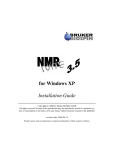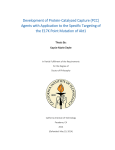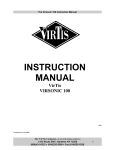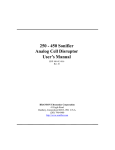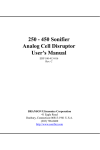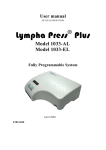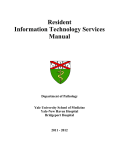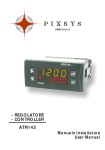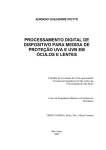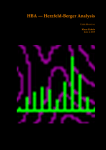Download High Resolution Magic Angle Spinning Spectroscopy
Transcript
High Resolution Magic Angle Spinning Spectroscopy User Manual Version BRUKER 001 The information in this manual may be altered without notice. BRUKER accepts no responsibility for actions taken as a result of use of this manual. BRUKER accepts no liability for any mistakes contained in the manual, leading to coincidental damage, whether during installation or operation of the instrument. Unauthorised reproduction of manual contents, without written permission from the publishers, or translation into another language, either in full or in part, is forbidden. This manual was written by Frank Engelke © March 4, 1998: Bruker Elektronik GmbH Rheinstetten, Germany P/N: Z31437 DWG-Nr: 1147001 Contents Contents .............................................................. iii 1 1.1 2 2.1 2.2 3 3.1 3.2 3.3 3.4 4 4.1 4.2 4.3 4.4 4.5 5 5.1 5.2 5.3 5.4 6 6.1 6.2 7 7.1 7.2 7.3 7.4 7.5 A Version 001 Introduction ............................................................ 5 Introduction ......................................................................... 5 System Description ................................................ 7 Probe Description ................................................................ 7 Site and Parts Requirements ............................................... 8 Installation of the Probe and Peripherals .............. 9 Probe Installation ................................................................ 9 Pneumatic connections ........................................................ 9 Electronic connections ....................................................... 11 MAS Sample Changer ....................................................... 11 Operation of the HR-MAS System ........................ 13 MAS Rotors, Caps and Inserts ........................................... 13 Sample loading .................................................................. 14 Cap removal ...................................................................... 14 Spinning the rotor under manual control ............................ 15 Spinning the rotor under computer control ......................... 16 Preparing the Probe for Experiments .................. 19 RF Tuning ......................................................................... 19 Adjusting the magic angle .................................................. 19 Shimming a HR-MAS probe ............................................... 21 Choosing the appropriate spinning speed. ......................... 23 Gradient HR-MAS Spectroscopy .......................... 25 Magic Angle Gradient Design ............................................ 25 Setting up the magic angle gradient ................................... 26 Application Examples ........................................... 31 Hr-MAS of small organic molecules ................................... 31 HR-MAS of swollen polymers ............................................. 35 MAS of biological samples ................................................. 36 Gradient hr-MAS spectroscopy .......................................... 39 Water suppression and Diffusion Studies with MAS gradients. 42 Shipping List ....................................................... 45 BRUKER iii Contents B Spherical Inserts ................................................. 47 C References ........................................................... 49 Figures ................................................................. 51 Tables .................................................................. 53 iv BRUKER Version 001 Introduction 1 Introduction 1 1.1 The line width of an NMR resonance depends strongly on the microscopic environment of the nucleus under study. Interactions such as the chemical shift and dipole-dipole coupling between neighboring spins are anisotropic and impose a dependence on the NMR frequency based on the orientation of a spin or molecule with respect to the main magnetic field direction. Furthermore, the magnetic susceptibility of the sample and susceptibility differences within the sample lead to a broadening of the resonances. In liquid state spectroscopy the rapid isotropic motion of the molecules averages the anisotropic interactions, resulting in an isotropic chemical shift frequency and a disappearance of the line broadening due to dipolar couplings. Furthermore the sample geometry, a cylinder parallel to the main magnetic field, is chosen such that the susceptibility broadening is minimized. In solid samples on the other hand, the lack of molecular mobility results in broad lines. This line broadening can be reduced by spinning the sample rapidly around an axis which is oriented at an angle θ m=54.7° with the direction of the magnetic field. By spinning at this so-called 'Magic Angle' (the angle between the z-axis and the (1,1,1) vector), at a rate larger than the anisotropic interactions, these interactions are averaged to their isotropic value, resulting in substantial line narrowing. In addition, magic angle spinning removes the magnetic susceptibility broadening. In addition to pure solids or pure liquids there is a wide range of materials which exhibit either reduced or anisotropic mobility. Examples include polymer gels1, lipids2, tissue samples3,4, swollen resins (used as supports in combinatorial chemistry)5,6,7, plant and food samples. While these samples generally have sufficient mobility to greatly average anisotropic interactions, the spectral resolution for the static samples are still much lower than that which is achieved for liquid samples. The excess broadening under static conditions is due to a combination of residual dipolar interactions and variations in the bulk magnetic susceptibility8. For a variety of samples, including the aforementioned examples, magic angle spinning is efficient at averaging these left-over components of the solid state line width, and leads to NMR spectra that display resolution approaching that of liquid samples. Such methods have been termed High Resolution MAS (HR-MAS) NMR. Bruker has developed a series of dedicated probes for standard bore magnets, to accommodate the rapidly expanding field of HR-MAS. These probes are available in double and triple resonance modes and come equipped with a deuterium lock channel. The probes have automatic sample ejection and insertion capability, with the availability of an optional sample changer, enabling fully automated sample runs. A B0 gradient, directed along the magic angle, is optional. Version 001 BRUKER 5 (55) Introduction Figure 1 demonstrates the gain in resolution that can be achieved with a HR-MAS probe, compared to a standard high resolution probe. The spectra are proton spectra of a human lipoma tissue, obtained at a frequency of 500 MHz. Figure 1.1. 500 MHz proton spectra of a human Lipoma tissue. 6.0 5.0 4.0 3.0 2.0 1.0 ppm The top spectrum is acquired in a conventional high resolution probe (spinning at 20 Hz // B0), while the lower spectrum is acquired in a HR-MAS probe (spinning at 5 kHz). 6 (55) BRUKER Version 001 System Description 2 2 Probe Description 2.1 The HR-MAS probes have been designed to perform solution type experiments, while spinning the sample at the magic angle. The probes are either doubly tuned (e.g. 1H and 13C) or triply tuned (e.g. 1H, 13C and 15N), in addition to a 2H lock channel. All three (or four) channels are operating via a single NMR transmit/receive solenoid coil located inside the MAS turbine (see figure 2.1). The probes are capable of performing either direct or indirect (inverse) detection experiments. Properties of the HR-MAS probes include: 1. MAS at spinning rates of up to 16 kHz for 4 mm o.d. Zirconia rotors for liquid or liquid-like samples and up to 6 kHz with spherical volume PTFE or Kel-F inserts; 2. Sample insertion/ejection without removal of the probe (up to 600 MHz); 3. Magic angle adjustment with micrometer screw at probe bottom; 4. Built-in heater/dewar and thermocouple for VT operation from -20°C to +70°C; 5. Optical spin rate counter with trigger signal output for rotor synchronized experiments; 6. Automatic insert and eject of the sample using the MAS sample changer. Figure 2.1. Upper probe chamber with MAS stator in magic angle position. Version 001 BRUKER 7 (55) System Description Site and Parts Requirements 2.2 Air requirements: 1. Free of oil and dust (0.01 micron filter); 2. Dew point of at least -30°C; 3. 4m3/h flow of air at more than 6 bar for stable, fast spinning; 4. Dry nitrogen gas for low temperature operation either from a pressurized liquid nitrogen tank with a nitrogen boil off device (a 60 liters gas cylinder (200 bar) lasts for approximately 1 hour); 5. B-VT 2000 or 3000 variable temperature unit for all variable temperature (VT) operation and a 25 liters liquid nitrogen dewar for low temperature operation. MAS equipment 1. MAS pneumatic control unit for sample spinning, display of the spinning rate, as well as sample insert and eject; 2. Set of air hoses and spinning rate cable; 3. Pneumatic sample transfer system for standard bore magnets; 4. MAS sample changer for automatic multiple sample insert and eject (optional). RF amplifiers HR-MAS probes are designed to operate with the standard RF transmitters. No high-power transmitters are needed! B0 gradient option For HR-MAS probes equipped with a magic angle gradient in addition to the above mentioned items, a gradient amplifier is needed. Gradient amplifiers capable of preemphasis and 10 A output current are recommended, such as the GREATTM or ACCUSTARTM. 8 (55) BRUKER Version 001 Installation of the Probe and Peripherals 3 3 Probe Installation 3.1 3.1 Probe Installation • Insert the probe into the lower shim stack. For easy shimming it is recommended to align the probe with the y-gradient direction, as described in section 5.3: “Shimming the HR-MAS probe”; • • Lower the sample transfer tube into the top of the shim stack; Place the MAS sample changer (optional) on top of the sample transfer tube (see section 3.4 MAS Sample Changer). Figure 3.1. Pneumatic connections of the HR-MAS probe. Pneumatic connections • • Version 001 3.2 Connect the MAS pneumatic unit to the main gas supply (see section 2.2); Connect the RS232 port of the pneumatic unit to tty08 on the console; BRUKER 9 (55) Installation of the Probe and Peripherals • For the connection of air hoses between the MAS control unit and the probe, refer to figure 3.1 and figure 3.2; • For low-temperature experiments the bearing gas connection has to be removed and the outlet of a heat exchanger has to be connected instead. See figure 3.3 for low-temperature operation; • Please note: Kel-F caps for Zirconia rotors can be used in the temperature range from +10°C to +50°C. For a more extended VT range (-30 to +70°C) the usage of caps made of macor or boron nitride are mandatory! Figure 3.2. Diagram for the pneumatic connections for operation at ambient temperature. Figure 3.3. Set-up for low-temperature operation The bearing gas (preferably dry N2 gas) is cooled by an heat exchanger immersed in liquid N2, and is directly fed into the glass dewar inlet at the bottom of the probe. 10 (55) BRUKER Version 001 Electronic connections Electronic connections 3.3 • Connect the X-channel of the probe to the X-BB HPPR preamplifier using a proton reject or a low pass filter; • Connect the 1H-channel of the probe to the proton using a proton band pass filter; • • • Connect the 2H-lock channel of the probe with the lock preamplifier; • (Connect the gradient cable to the gradient connector on the side of the probe); • (Connect the Y-channel to the probe via a low pass filter). Connect the spin rate cable from the MAS unit; For variable temperature operation connect the heater cable and the thermocouple from the rear panel of BVT 2000 unit or the front panel of the BVT 3000 unit; MAS Sample Changer 3.4 The Bruker MAS sample changer is designed to allow the acquisition and processing of MAS data from up to 20 samples without operator intervention. The sample changer is mounted on top of the sample transfer tube and controlled via the insert and eject pneumatic lines of the MAS controller. To install the device, remove the upper sleeve of the sample transfer tube and place the sample changer on top of the tube. Connect the air lines as indicated in figure 3.4. The rotors are stacked in the sample changer (with the rotor caps upward) and after ejection are gathered in the collection tray. The rotor collection tray may be removed and emptied, and additional rotors may be inserted into the sample changer while the system is in operation, allowing for indefinite operation with only infrequent operator intervention. In order to distinguish the samples, numbered rotor barrels are available. Version 001 BRUKER 11 (55) Installation of the Probe and Peripherals Figure 3.4. Installation of the MAS sample changer. VDPSOHFKDQJHU 0$6XQLW 287 $1*/( (-(& 7 VDPSOH WUDQVIHU WXEH ,1 6 ( 5 7 7R3UREH 0 $* 1 (7 12 (55) BRUKER Version 001 Operation of the HRMAS System 4 MAS Rotors, Caps and Inserts 4 4.1 The rotors most commonly used for MAS are made of zirconium oxide (Zirconia). Rotors can be either filled entirely with sample or they can be used with rotor inserts. Inserts are provided to improve shimming and RF in homogeneity, and are useful when the amount of sample is limited. The maximum spinning rate for 4 mm Zirconia rotors is about 15 kHz, but is limited to lower speeds when using the spacers. A full rotor has a sample volume of about 80 ml; with a spherical insert the volume is reduced to about 25 µ l. Numbered rotors are available to easily distinguish between different samples. The function of the rotor cap is twofold: firstly, to close the rotors, and secondly, to provide the driving of the rotor. There are several types of caps available. The standard caps are made of Kel-F, which can be used in a temperature range from 10°C to +50°C. This material will shrink at lower temperatures and soften at more elevated temperatures. However, for a more extended VT range (-30°C to +70°C) caps made from macor or boron nitride can be used. Those materials have temperature coefficients similar to Zirconia. Figure 4.1. Zirconia rotor with Kel-F cap, upper spacer, cylinder head screw,. and sealing grub screw to provide a spherical sample volume Version 001 BRUKER 13 (55) Operation of the HR-MAS System The most common type of rotor spacers provide a sample volume that is approximately spherical in order to improve the shimming of the probe (see figure 4.1 and figure 4.2. Appendix B is an example of an instruction sheet showing how to handle this type of insert. For other inserts please refer to the accompanying instructions provided with the spacers. Figure 4.2. Schematic drawing of the rotor with spherical insert. Upper spacer Sample Lower Spacer Sample loading Grub Screw Rotor Cap 4.2 In order for the rotor to spin stable and fast, the rotor has to be well balanced. Load the sample loosely into the rotor barrel and tap the rotor lightly on a hard surface. Do not attempt to pack the material tightly into the spinner. If you wish to add more sample into the rotor, it is better to spin up the rotor first, so that the sample is packed against the walls of the barrel, and then add additional material. Liquid or viscous samples are easily loaded using a syringe or a small pipette. Solvent swelling can be done with the powdered sample in the rotor. Push the rotor cap on all the way; if the cap is improperly positioned the rotor may not spin. Clean the outside of the rotor with a tissue, so that no sample ends up in the MAS stator. Mark half of the beveled rim on the bottom of the rotor with a black marker for optical spin rate detection. For loading samples using spherical inserts, see Appendix B or the instruction sheet that came with the inserts. Cap removal 4.3 The rotor cap is easily removed with a dedicated cap removal tool (see figure 4.3). Screw the tool body loosely to the cap clamp. Insert the cap all the way into the teeth of the clamp. Screw the tool body snugly, but not too tight, onto the clamp. Insert the rotor into the barrel clamp and remove the cap by simultaneously rotating and pulling the barrel clamp. Unscrew the cap clamp and push the cap out with the push pin. Be careful not to damage the caps. (For more complete instructions please refer to the guidelines delivered with the cap removal tool). 14 (55) BRUKER Version 001 Spinning the rotor under manual control Figure 4.3. Schematic drawing of the cap removal tool. cap clamp tool body barrel clamp cap push pin rotor Spinning the rotor under manual control 4.4 Prepare the pneumatic unit for operation by setting the proper probe parameters such as rotor size (BL4), magnet (SB) and rotor material (e.g. ZrO2). Consult the manual for the pneumatic unit and/or section 4.4 of this manual. For manual operation of the MAS pneumatic unit, set the unit in the local mode by pressing the local/remote button on the keypad of the pneumatic unit. Choose either manual or automatic for spinning control (see below). It is also possible to operate the pneumatic unit from your host computer. For this, please refer to the XWINNMR manual and section 4.5. Inserting the rotor In order to make sure that the rotor will properly drop into the stator press the eject button on the pneumatic unit first. This will set the stator into a vertical position and ensure that a rotor which might be inside the probe will be ejected. After the eject air is on (and after removal of a rotor which has been in the probe) press stop. Then the packed rotor can be dropped into the probe via the transfer tube with the cap up. Close the insert tube and press the button insert on the pneumatic unit. This will automatically set the stator into the magic angle position after 10 seconds, if the pneumatic unit is operated in automatic mode. In manual mode you have to press the stop button again. Spinning the sample If the pneumatic unit is set to operate in automatic mode, you may start spinning the sample by setting the desired spin rate (Vd) and pressing the go button on the control panel. In case the rotor does not reach the desired spin rate in automatic mode, the rotor has to be spun up in manual mode. For spinning up 4 mm Zirconia rotors in automatic mode, set the start bearing pressure to about 800 mbar, the default setting of 2000 mbar is too much for most samples. This can be done by pressing the bearing button in automatic mode and reducing the displayed Bp start to the desired value. For manual spinning of the 4 mm Zirconia rotors use 800 mbar bearing (Bp) and 150 mbar drive pressure (Dp) to obtain a spin rate above 2.5 kHz. If the spinning rate achieved at these pressures is lower, slowly decrease BP to 100 mbar and immediately increase BP as soon as the rotor accelerates. Standard samples will Version 001 BRUKER 15 (55) Operation of the HR-MAS System easily spin in a 4 mm system, problems can be encountered for conductive materials or very heavy solid samples. Stopping sample spinning In automatic as well as in manual operation the rotation can be stopped by pressing the stop button. If you want to stop rotation manually from the keypad, decrease the drive pressure (Dp) first, and then lower the bearing pressure (Bp) slowly. In order to stop spinning after variable temperature experiments, make sure that the heater is off and that gas of ambient temperature is used for the bearing! Sample Ejection After the rotor has stopped press the eject button on the pneumatic unit. The stator will switch back to the vertical position and the rotor be ejected. For this procedure the eject air pressure has to be adjusted by a little adjust knob on the rear of the pneumatic unit such that the pressure is high enough for the rotor to lift off, but not too high, such that the cap is not damaged when the rotor knocks against the closure of the transfer tube. Spinning the rotor under computer control 4.5 The MAS window In order to operate the MAS pneumatic unit from XWINNMR, the unit has to be run in remote mode, which can be selected on the keypad on the front of the unit. The set-up of and communication with the pneumatic unit is established by typing cfmas on the XWINNMR command line and answering the questions in accordance with your set-up. The control of the pneumatic unit from the host computer is initiated by typing MAS on the command line. This brings up the MAS control window, shown in figure 4.4. Start by selecting the correct probe parameters or reading them in from a previously saved probe setup file. Press Eject Sample to flip the stator in the upright position and eject a rotor which might be in the probe. After the eject air is off, insert the rotor and click Insert Sample to flip the stator to the magic angle position. Enter the desired spinning rate and select spinning on to start spinning. By pressing Continuous Update the actual values of the bearing and drive pressure and the spinning rate will be updated every 10 s. After the rotor reaches the desired spinning rate and the spinning is stable, the Spin Locked parameter will be set to Yes. Exit the menu by pressing cancel. The spin rate can still be monitored on the computer screen by selecting MAS rate monitor from the windows menu of XWINNMR. Spinning can be halted by re-entering the MAS menu and selecting spinning off (note that when you enter the MAS window, spinning is always set to off, however, you will have to activate this to stop the spinner). Press Continuous Update to monitor the spinning rate. Once the spinner is stopped press Eject Sample to remove the sample. 16 (55) BRUKER Version 001 Spinning the rotor under computer control Figure 4.4. MAS pneumatic unit control window. Command line control In addition to using the MAS window (figure 4.4) the following commands can be used to control the spinner from the command line of XWINNMR: • • • • • • Version 001 masr: set the spinning rate (Hz) masg: start spinning mash: stop spinning mase: eject sample masi: insert sample masrmon: MAS spinning rate monitor (continuous). BRUKER 17 (55) Operation of the HR-MAS System 18 (55) BRUKER Version 001 Preparing the Probe for Experiments 5 RF Tuning 5 5.1 The RF tuning is performed by centering the dip of the wobble curve on the screen through turning the tuning and matching rods at the bottom of the probe. The rods for the 1H channel are labeled yellow, the rods for the 13C channel are labeled blue. The tuning bandwidth of the 13C channel is equal to a few MHz. The 2 H lock channel is fixed, i.e., no external matching and tuning adjustment is necessary. Always tune the probe while the sample is spinning. When tuning the probe pay attention to the wobble curve. If modulations are superimposed on the wobble curve, this is usually a sign that the sample spinning is not stable. Adjusting the drive and bearing pressures or restarting the spinner can stabilize the spinning. If problems persist, repack the sample. Adjusting the magic angle 5.2 The precise setting of the magic angle is mandatory to obtain the maximum spectral resolution obtained by MAS. In order to adjust the magic angle, a sample is needed with an NMR line that is very sensitive to angle misalignment. Suitable samples are BaClO3H2O (1H observe) and KBr (79Br observe). For both samples, to adjust the angle the sample has to be spun at about 5 to 6 kHz. Note that either sample can be used to set the angle, irrespective of what nucleus will be observed in the HR-MAS experiments. For the proton sample a spectrum is acquired and Fourier transformed. The magic angle setting is then slightly changed by turning the micrometer screw at the bottom of the probe. Take another spectrum and repeat the procedure until the magic angle setting is optimal (see figure 5.1). Version 001 BRUKER 19 (55) Preparing the Probe for Experiments Figure 5.1. Proton NMR spectra of BaClO3H2O off magic angle at magic angle Obtained off the magic angle (top) and obtained with the correct angle setting (bottom). Experimental parameters: ns = 1, swh = 125kHz, pulse program zg, p1 = 3µs, pl1 = 0 dB, d1 = 5s, spinning rate 6000 Hz. The 79Br resonance frequency is very close to the 13C resonance frequency, thus no or just a slight tuning of the RF-circuit is necessary. Furthermore KBr provides a very sensitive signal with a very short T1. Already at moderate spin rates the satellite transition will be split into sidebands, which have to be as narrow as possible for the optimum angle setting. With a rotor completely filled with KBr, the angle setting procedure can be performed in “gs” mode on the free induction decay (FID). In “gs” mode, go to the “acqu” window, separate the real and imaginary part of the FID and adjust for an on resonance decay. This can be done by changing “o1” or adjusting the field. Make sure that the field sweep is off and remains off! If the angle is close to the magic angle, you will see rotational echoes on top of an exponential decay (figure 5.2). Far off angle only the exponential decay is visible. Turn the micrometer screw until the rotational echoes last up to 4 ms. Write down the setting of the micrometer screw at the probe bottom for the correct angle position. Check for the optimal setting by acquiring 32 scans and maximizing the number of sidebands in the spectrum (figure 5.3). 20 (55) BRUKER Version 001 Shimming a HR-MAS probe Figure 5.2. 79Br FID’s KBr. off magic angle at magic angle Experimental parameters for acquisition: pulse program = zg, swh = 100kHz, td = 2k, d1 = 30ms, p1 = 2µs, pl1 = 0dB, spinning rate 6000 Hz. Figure 5.3. 79 Br NMR spectra corresponding to the FID's shown in figure 5.2. off magic angle at magic angle Shimming a HR-MAS probe 5.3 When shimming a high resolution probe one distinguishes between on-axis (z) and off-axis (x, y etc.) shims. Spinning the sample parallel to the magnetic field di- Version 001 BRUKER 21 (55) Preparing the Probe for Experiments rection averages the off-axis in homogeneity, which may result in spinning sidebands. In MAS spectroscopy the spinner axis is at an angle θ m with the magnetic field direction and the distinction between the traditional on-axis and off-axis shims no longer holds. The spinning rates in MAS spectroscopy, however, are typically at least a few kilohertz, which is much larger than the magnetic field in homogeneity. As a result the amplitudes of the sidebands are small and shimming may be done with a set of shims that is cylindrically symmetric about the MAS spinner axis. Such a set of shims can be constructed from combinations of the standard laboratory frame shims, via a transformation to the tilted magic angle frame9. In the simplest implementation the MAS probe is aligned such that the spinner axis is in the laboratory xz-plane (figure 5.4). Figure 5.4. The magic angle spinner axis z shim plate y x leads The magic angle spinner axis is aligned with the xz-plane of the shims by positioning the front plate of the probe parallel to the direction of the shim leads. The ’magic angle z-shims’ are listed below for orders Z through Z5. The simplest approach is to use the laboratory shims with the largest coefficient, so for instance the X shim is used as the normal high resolution Z shim. Complete shimming can then in principle be accomplished using only X, ZX, Z2X, Z4 and Z5 as the surrogate nth order on-axis shims. Note, however, that the coefficients given for the magic angle shims do not take into account the efficiencies of the shim coils and the use of the other shims listed below may be needed. 22 (55) BRUKER Version 001 Choosing the appropriate spinning speed. To shim the HR-MAS probe, a sample of 3%CHCl3 in Acetone-d6 is suggested, using a rotor with a spherical insert. Make sure the magic angle is adjusted prior to shimming the probe. Spin the sample at a rate suggested in the following section. It is always best to shim up the probe already under the conditions used later for the real samples. Make sure, that the correct gas is used for temperature control and spinning, the coils can be optimized for air or nitrogen gas. To obtain best results, the gas indicated should be used. Lock the sample, tune the probe and start shimming using the X, ZX, Z2X, Z4 and Z5 shims as described above. If one of the shims requires an excessive shim current, reduce the current and continue shimming by adding current to another shim from the same group as shown in the table. For instance if the current in ZX is too high, reduce the value and optimize the line shape by adding current to the (X2Y2)Z shim. If the probe is not exactly aligned with the xz plane (see figure 5.4), then a small amount of Y and YZ may be needed for optimal shimming. A second shim set should be obtained for rotors without spacers, and the optimal shim settings for these will be somewhat different. Under normal conditions the shim values obtained as described above, will be close to optimal for all other samples. When changing samples one usually only needs to adjust Z (and ZX). Both shim value sets should be stored on disk. Make sure when the shim values are stored that the HR-MAS probe is defined as the current probe in the EDHEAD command, then shims can be recalled with the correct lock conditions like phase and power. Choosing the appropriate spinning speed. 5.4 The correct spinning speed depends strongly on the sample under study. A minimum spinning speed is recommended, which depends on the field strength of the magnet: Version 001 300 MHz 2400 Hz spinning 400 MHz 3200 Hz spinning 500 MHz 4000 Hz spinning 600 MHz 4800 Hz spinning BRUKER 23 (55) Preparing the Probe for Experiments These spinning speeds are chosen to prevent spinning sidebands to fall into regions of interest for typical proton samples. For some samples, such as for instance in biological tissues, higher spin rates may be beneficial. Keep in mind, however, that this may result in irreversible changes in the sample due to the breakdown of cellular structures and that the rotation may lead to significant sample heating (as much as 10°C). In the case of very fast spinning it is a good practice to acquire spectra at lower spinning speeds both before and after the fast spinning and compare those spectra to ensure that no changes have occurred in the sample. Figure 5.5 displays proton spectra of a plant leaf, acquired at spinning speeds of 4 kHz, 10 kHz, 19 kHz and 6 kHz. The spectrum at 6 kHz is obtained after spinning at 19 kHz and shows that no irreversible changes have taken place. Figure 5.5. Proton spectra of a plant leaf Effect of spinning speed on 400 MHz HR-MAS proton spectra of a plant leaf, cut and flushed in water. The spectra are displayed with absolute intensity scaling. The spectrum obtained at 6 kHz is acquired after spinning at 19 kHz and shows that no irreversible changes due to spinning have taken place. 24 (55) BRUKER Version 001 Gradient HR-MAS Spectroscopy 6 6 The addition of a magnetic field gradient to a high resolution MAS probe leads to further advances in this type of spectroscopy10. Based on the broad acceptance of gradient methods in high resolution solution state NMR studies11, it is not surprising that gradients can be of use in HR-MAS measurements, particularly since the NMR methods are adopted from the liquid state, rather than from the solid state class of methods. As in high resolution liquid state studies, the gradient is essential for removing t1 noise and is extremely helpful in coherence pathway selection. Magic Angle Gradient Design 6.1 In conventional high resolution spectroscopy with gradients, the gradient field most commonly used is aligned with the main magnetic field direction, a so-called z-gradient. Although the sample is usually stationary in gradient spectroscopy, for reasons discussed later, it is in principle possible to rotate the sample, since the isoplanes of the gradient field are perpendicular to the rotation axis (see figure 6.1). This means that a rotating spin will always experience the same magnetic field strength. Figure 6.1. Use of a z-gradient in MAS spectroscopy γGz z z x x If in conventional high resolution spectroscopy with a z-gradient the sample would be spun, then the spins will always experience the same magnetic field strength. In MAS spectroscopy, however, the use of a z-gradient would cause a rotating spin to sample different values of the magnetic field. Version 001 BRUKER 25 (55) Gradient HR-MAS Spectroscopy If a z-gradient would be applied to a sample spinning at the magic angle, the rotating spin would pass through different isoplanes, since the axis of rotation is no longer parallel to the direction of the magnetic field gradient (figure 6.1). This would result in a partial averaging of the gradient field as experienced by the spins, and would necessitate the need to synchronize one’s experiments with the spinner rotation (which may be difficult or even impossible due to the finite rise and fall times of the pulsed gradient fields). A better solution is to implement gradient spectroscopy experiments in a MAS probe in such a way that the gradient should introduce a resonance that is not temporally modulated. This may be accomplished with a time-independent gradient field where the gradient is oriented such that the z-component of the magnetic field increases along the axis of the spinner and the z-component of the magnetic field gradient is uniform in the planes perpendicular to the spinner axis (see figure 6.2). Figure 6.2. Gradient field is directed along the magic angle spinner axis z γGmas y x If in MAS spectroscopy the gradient field is directed along the magic angle spinner axis then a rotating spin will always sample the same magnetic field strengths. The HR-MAS probe is optionally equipped with a magic angle gradient12. The gradient coil design is compatible with commonly used MAS stators (for widebore and standard bore probes) and does not interfere with the automatic sample ejection and insertion capabilities. Gradient strengths of up to 45 G/cm (at 10A) can be achieved. Setting up the magic angle gradient 6.2 Before the magic angle gradient can be used in a routine fashion a few adjustments have to be made. In order to ensure short rise and fall times of the pulsed field gradients it is necessary to compensate for Eddy currents generated by the gradient pulses and for the switching times of the gradient amplifier. This is done through so-called pre-emphasis adjustment. Furthermore the gradient strength 26 (55) BRUKER Version 001 Setting up the magic angle gradient needs to be calibrated. Before initiating these adjustment procedures make sure that the gradient amplifier has been installed correctly. Adjusting the pre-emphasis Figure 6.3. Pre-emphasis controller window. For this procedure use a rotor with H2O/D2O, preferably doped with CuSO4 (2 mMol). Spin the sample at approximately 3 kHz, lock and shim to a proton line width of better than 5 Hz at half height. Set the offset a few kHz off resonance from the water peak. Use a sweep width of 20 ppm, D1=1-2s, and choose TD such that the FID has decayed about 50% in amplitude after approximately 1/8th of the acquisition time. Next set the pulse program to preempgs (for RX22 based systems set the second channel to proton as well). Use a gradient program which defines a single square gradient pulse (e.g. gradprog=1squa) and define a variable delay list (vdlist=preemp) which contains the following values: 100 µ l, 300 µ l, 1m, 3m, 10m, 30m, 100m, 300m. This pulse program will acquire 8 FID’s and display them sequentially in a single acquisition window (see figure 6.4). Each FID is acquired at a time vd after a gradient pulse. Set the gradient pulse length to 50 ms and its strength to 20%. The pre-emphasis is controlled by a set of three time constants and amplitudes. These values can be addressed through the Pre-emphasis Controller window, which is invoked by setpre (figure 6.3). Select for the time constants 20 ms, 2 ms and 200 µ s and start with 50% for all time settings and 0% for all gain settings. Start the acquisition in gs mode and observe the FID’s in the acquisition window. With the time constants set as described above, the first FID’s will seem distorted, as can be seen in the example of figure 6.4 (top spectra). Adjust the pre-emphasis values by changing the time constants and gain settings. Start with the settings for the slowest time constant and adjust the 5th and 6th FID, so that they appear similar to the last two FID’s. Repeat the procedure for the mid and fast Version 001 BRUKER 27 (55) Gradient HR-MAS Spectroscopy time constants, for FID’s 3 and 4, and FID’s 1 and 2, respectively. If all values are set correctly all FID’s should appear equal (figure 6.4, bottom). The pre-emphasis values are dependent on both the probe and the gradient amplifier and once correctly set up, will remain the same. The settings can be stored on the computer by saving the set-up from the file menu in the Pre-emphasis Controller window. Figure 6.4. 8 consecutive FID’s 0.2 0.4 0.6 0.8 1.0 1.2 1.4 1.6 1.8 2.0 2.2 sec 0.2 0.4 0.6 0.8 1.0 1.2 1.4 1.6 1.8 2.0 2.2 sec Acquired at different times after the application of a gradient pulse. Top: without pre-emphasis; bottom: with pre-emphasis properly adjusted. Calibrating the gradient Gradient calibration is performed by measuring the gradient profile of a sample of known size. Usually a proton spectrum of a sample of water is acquired. The profile is obtained with a gradient spin-echo, which can be acquired with the pulse program calib. Set the gradient amplifiers to a low output, e.g. 10 or 20% and acquire 4 scans. Multiply the FID with a sinebell (ssb=0), Fourier transform and represent the data in magnitude mode (mc). The resulting profile represents a projection of the sample’s density along the magic angle spinner axis. For a sample of known length the gradient strength can be determined by measuring the width of the spectrum ( ∆ω) and dividing it by the length of the sample (l, in cm), by the gyromagnetic constant of protons ( γ =4250 Hz/G) and by the current of the gradient amplifier (I in A): 28 (55) BRUKER Version 001 Setting up the magic angle gradient G= ∆ω , in Gcm-1 A -1 γ lI In figure 6.5 below, water in a spherical insert is used to calibrate the gradient strength. The profile represents the spherical sample volume plus a small amount of water in the fill hole of the inserts. From the width of the profile ( ∆ω=12000 Hz) and the known length of the sample (l=0.27 cm) and gradient amplifier output (20% of 10A), the gradient strength is determined as 5.2 Gcm-1A-1. Figure 6.5. Gradient profile for a spherical sample of water. sphericalsample volume fillhole 15000 10000 5000 0 -5000 -10000 -15000 Hz The gradient strength is obtained from the width of the profile. Version 001 BRUKER 29 (55) Gradient HR-MAS Spectroscopy 30 (55) BRUKER Version 001 Application Examples 7 7 High resolution MAS provides an easy means of obtaining high resolution spectra of a variety of samples that would otherwise result in poorly resolved spectra, due to residual anisotropic interactions. The addition of a HR-MAS probe and a MAS pneumatic unit to a standard high resolution spectrometer is all that is needed to open a gate to the world of HR-MAS spectroscopy and access to a vast amount of highly interesting samples. In this section a number of application examples are shown from a variety of compounds. All spectra are acquired with standard high resolution techniques. Hr-MAS of small organic molecules 7.1 There is a wide variety of conceivable applications for HR-MAS probes. Among others, one important field for pharmaceutical research concerns combinatorial chemistry. In combinatorial chemistry, small organic molecules are synthesized on resin beads, consisting of a polymer matrix and a linker material. NMR is advantageous in analyzing these samples since the reactions can be monitored without cleaving off the substrate. High resolution NMR spectra are obtained by swelling the beads in a deuterated solvent in combination with Magic Angle Spinning. An example from this field is illustrated in figure 7.1. The proton spectrum is obtained from 2 mg of a meta- and para-disubstituted aromatic ring on tentagel resin, swollen in d-chloroform and acquired with a CPMG sequence. The broad resonances of the polymer resin are distinguished from the substrate resonances by exploiting the differences in proton T2’s using the CPMG sequence as is demonstrated in figure 7.2. Further information on these compounds is obtained from two dimensional NMR techniques. Figures 7.4 and 7.5 show a J-resolved and a double quantum filtered Cosy spectrum of the same compound, respectively. Version 001 BRUKER 31 (55) Application Examples Figure 7.1. 1H hr-MAS NMR spectrum of small organic molecules Tentagel bead O O O n O (n = 10 -15) Polystyrene resin O Linker O N H Substrate a a a: para disubstituted aromatic b: meta disubtituted aromatic b b 7.2 7.1 b b 7.0 6.9 6.8 6.7 6.6 6.5 (ppm) including a meta- and para-disubstituted aromatic ring on tentagel resin, obtained under the following NMR conditions: DRX400, 2mg in 4mm rotor with spherical spacer, swollen in d-chloroform, cpmg 40msec, 3200Hz spinning, smallest line width at half height 2.7 Hz. Figure 7.2. Comparison of proton spectra 8.0 7.8 7.6 7.4 7.2 7.0 6.8 6.6 6.4 6.2 6.0 (ppm) obtained with a single pulse (top) and with a CPMG sequence (bottom). The resonances of the resin are suppressed in the lower spectrum, by employing a CPMG 32 (55) BRUKER Version 001 Hr-MAS of small organic molecules sequence ( τ - π - τ )*n, with τ =1.5 ms and n=20. Avance 400 MHz, 3200 Hz spinning, 2 mg sample on Tentagel substrate, swollen in deuterated chloroform. Figure 7.3. Figure 23: 400 MHz proton spectra of a single 100 µ m bead re s in 8.4 8.0 7.6 7.2 6.8 6.4 (ppm) (top), separated under the microscope (volume 0.5 nl,1056 scans, weight 600 picograms) and 2mg of the same sample, swollen in CDCl3, (8scans). Avance 400, 3200 Hz spinning. Figure 7.4. 2D J-resolved proton spectrum of 2 mg sample on a Tentagel resin, swollen in CDCl3. Avance 400 MHz, 4 scans, MAS 3200 Hz. Version 001 BRUKER 33 (55) Application Examples Figure 7.5. Double Quantum filtered Cosy of a small organic molecule on a Tentagel resin. Avance 400 MHz, 16 scans, 2 mg sample, MAS 3200 Hz. In a different application of hr-MAS to the study of small organic molecules, spots were scratched off a TLC plate and made into a slurry with D2O. Figure 7.6 shows the proton spectrum of approximately 15 µ g of salicylic acid from a TLC plate. 34 (55) BRUKER Version 001 HR-MAS of swollen polymers Figure 7.6. Hr-MAS spectra of TLC-plate spots. 3.50 7.80 7.70 7.5 7.60 7.0 7.50 (ppm) 6.5 7.40 6.0 3.45 3.40 3.35 (ppm) 3.30 7.30 5.5 5.0 4.5 4.0 (ppm) 3.5 3.0 2.5 2.0 1.5 1.0 0.5 The compound is 15 micrograms of salicylic acid, scratched of the TLC plate and slurried with D2O. Avance-600 MHz, 64 scans, 4200 Hz spinning. HR-MAS of swollen polymers 7.2 Some polymers are nearly insoluble and as a result, obtaining high resolution NMR spectra may become impossible. An example is a range of poly acethylene derived polymers. These samples show an extremely low solubility in most common solvents and attempts to obtain solution spectra result in low signal to noise ratios and long measurement times. Solid state spectra, on the other hand, can be obtained but generally display a poor resolution. A solution to this dilemma is to swell the polymer with a solvent and to acquire spectra while spinning at the magic angle. Figure 7.7 displays proton and carbon spectra of a derivative of poly acethylene, swollen in chloroform. The carbon spectrum was obtained in about two hours. Version 001 BRUKER 35 (55) Application Examples Figure 7.7. 500 MHz proton (top) and carbon (bottom) spectra 8 7 180 6 160 5 140 4 120 3 100 2 80 1 60 0 40 ppm 20 ppm of a derivative of poly acethylene, swollen in deuterated chloroform. MAS of biological samples 7.3 Plant, tissue and food samples can be investigated by HR-MAS NMR. The usefulness of magic angle spinning within these fields of study is demonstrated in the examples shown below. Figure 7.8 shows a 1H 2D TOCSY spectrum of a sample of orange peel under MAS. In figure 7.9 the 800 MHz proton spectrum of red perch filet is shown. Figure 30 shows spectra of benign and malignant prostate tissues, obtained via biopsies. The cancerous tissue shows a strongly enhanced lipid content. Figure 7.11 displays a TOSCY spectrum, obtained from a living white worm, which allows one to study drug metabolism in vivo. 36 (55) BRUKER Version 001 MAS of biological samples Figure 7.8. 2D TOCSY/ hr-MAS spectrum of orange peel, cut to small pieces, flushed and measured in D2O, obtained under the following NMR-conditions: Avance-400, 2800Hz spinning, 4mm-rotor with spherical insert, 2.7mg of sample, phase sensitive 2D-TOCSY with presaturation of the residual water signal, 8 scans/400 increments, linear prediction to 800 points in f1, window function shifted sine bell squared in both directions (ssb=2). Figure 7.9. 8 mg red perch filet, cut, flushed and measured in D2O. 9 8 7 (ppm) 9 8 7 6 5 4 3 2 (ppm) Avance-800, 128 scans 15KHz spinning. Version 001 BRUKER 37 (55) Application Examples Figure 7.10. Hr-MAS of benign versus malignant human prostate tissue x 10 3.2 2.8 2.4 2.0 (ppm) 1.6 1.2 0.8 Hr-MAS of benign (top two spectra) versus malignant (bottom) human prostate tissue. Avance 400 MHz, 4000 Hz spinning. The cancerous tissue shows a strongly enhanced lipid content. Figure 7.11. TOCSY-presat of a living white worm (enchytraed) in 95% H2O/5% D2O. Avance-400 8scans/300incr. MAS 2800 Hz. 38 (55) BRUKER Version 001 Gradient hr-MAS spectroscopy Gradient hr-MAS spectroscopy 7.4 The benefits of using magnetic field gradients in high resolution spectroscopy have been well documented. In high resolution MAS similar benefits are seen from the use of gradients, in particular a reduction in a variety of artifacts, such as t1-ridges and repetition artifacts, while also saving time by eliminating the need to complete a full phase cycle. A number of gradient high resolution MAS experiments are shown below on a variety of samples. Figure 7.12 shows the gradient COSY of a swollen Wang resin, used in combinatorial chemistry. The use of gradients eliminates the repetition artifacts and t1-ridges. Note that the spinning sidebands in the f1-direction are aliased since no bandwidth filters are used in the indirect domain and the spectrum is not symmetrized. Figure 7.12. Gradient COSY of a swollen Wang resin -6 -4 -2 0 2 4 ppm ppm 8 6 4 2 0 500 MHz gradient 1H-1H COSY spectrum of an N-FMOC-N-Boc-L-Lysine derivatized Wang resin swollen with CDCl3. MAS 3.5 kHz, 1 ms gradients, 10 G/cm. Gradients are frequently used in inverse detected heteronuclear correlation experiments to select the magnetization from protons coupled to a 13C spin and suppress the uncoupled protons magnetization. The spectra below show 1H-13C hrMAS HMQC (figure 7.13) and HMBC (figure 7.14) spectra of a Wang resin, used in combinatorial chemistry. Note the excellent suppression of t1-noise in the gradient HMQC spectrum (figure 7.13, left) versus the phase cycled spectrum (figure 7.13, right) and the clean noise floor in the HMBC spectrum (figure 7.14). Note Version 001 BRUKER 39 (55) Application Examples that no attempts were made to improve the spectral quality (e.g. by t1-ridge subtraction). Figure 7.15 shows another example of a gradient HR-MAS HMBC spectrum. The spectrum is obtained from a human lipoma tissue and demonstrates the usefulness of this type of high resolution MAS spectroscopy to the study of biological tissues. Figure 7.13. 400 MHz 1H-13C HMQC spectra of an N-FMOC-N-Boc-L-Lysine 25 50 75 25 100 50 75 125 100 125 150 150 ppm ppm ppm ppm 8 6 4 2 8 6 4 2 0 0 derivatized Wang resin swollen with CDCl3. The left spectrum is acquired using gradients to suppress the magnetization from uncoupled proton spins, while the spectrum on the right is obtained with phase cycling. No attempt was made the improve the appearance of the spectra. MAS 5 kHz, 1 ms gradients, 10,10 and 5 G/cm. 40 (55) BRUKER Version 001 Gradient hr-MAS spectroscopy Figure 7.14. 400 MHz 1H-13C HMBC spectra of an N-FMOC-N-Boc-L-Lysine 25 50 75 25 50 100 75 125 100 125 150 150 ppm ppm ppm ppm 8 6 4 2 8 6 4 2 0 0 derivatized Wang resin swollen with CDCl3. A J-evolution time of 50 ms is used to reveal long-range proton- carbon correlations. No 13C decoupling is applied during acquisition. The right spectrum shows the noise floor and demonstrates excellent artifact suppression. MAS 5 kHz, 1 ms gradients, 10,10 and 5 G/cm. Figure 7.15. 500 MHz 1H-13C Gradient hr-MAS HMBC spectrum 0 25 50 75 100 125 150 ppm ppm 5 4 3 2 1 of a human Lipoma tissue (sample courtesy of Dr. Singer, Brigham and Women’s Hospital). MAS 5 kHz; 1 ms sine-shaped gradient pulses. Version 001 BRUKER 41 (55) Application Examples Water suppression and Diffusion Studies with MAS gradients. 7.5 Gradients allow for fast and efficient water suppression. Figure 7.16 shows spectra of a hydrogel in which the water is suppressed with the Watergate13 sequence. An alternative gradient method is the so-called Dryclean14 sequence in which a stimulated echo sequence is used to attenuate resonances based on differences in the diffusion rates of the molecules. Figure 7.17 shows spectra of a biological tissue in which the water signal is suppressed using Watergate and Dryclean, respectively. Figure 7.16. 500 MHz single pulse proton spectrum of an acrylamide hydrogel 9.0 8.0 7.0 6.0 5.0 4.0 3.0 2.0 1.0 ppm (top). The spectrum below is acquired with the Watergate method. 1 ms sineshaped gradient pulses are use with a strength of 30 G/cm. (sample courtesy of Prof. Tanaka, Massachusetts Institute of Technology). 42 (55) BRUKER Version 001 Water suppression and Diffusion Studies with MAS gradients. Figure 7.17. 500 MHz proton spectra of human high grade Pleiomorphic 5 .5 5.0 4.5 4.0 3.5 3.0 2 .5 2 .0 1.5 1.0 0.5 ppm Liposarcoma tissue (sample courtesy of Dr. Singer, Brigham and Women’s Hospital). MAS 5 kHz. Top: single pulse excitation; center: Watergate; bottom: Dryclean. The combination of magnetic field gradients and hr-MAS spectroscopy allows one to measure the diffusion constants of molecules in tissue samples under high resolution conditions. Figure 7.18 displays a series of proton spectra of a Liposarcoma tissue, obtained with a Stimulated Echo (STE) sequence. The spectra are acquired with increasing gradient strengths. Apart from measuring diffusion, the stimulated echo sequence is used for spectral editing by attenuating the resonances from mobile components in the sample (see figure 7.19). Version 001 BRUKER 43 (55) Application Examples Figure 7.18. 500 MHz STE diffusion spectra G 10 9 8 7 6 5 4 3 2 1 0 -1 ppm of a high grade human Pleomorphic Liposarcoma tissue (sample courtesy of Dr. Singer, Brigham and Women’s Hospital). MAS 10 kHz; 10 ms gradients,0-40 G/ cm, TE=100 ms. Figure 7.19. 500 MHz STE proton spectrum (top) and single pulse spectrum 9 8 7 6 5 4 3 2 1 0 p 9 8 7 6 5 4 3 2 1 0 p (bottom) of a high grade human Pleomorphic Liposarcoma tissue (sample courtesy of Dr. Singer, Brigham and Women’s Hospital). MAS 10 kHz; 10 ms gradients,30 G/cm, TE=100 ms. 44 (55) BRUKER Version 001 Shipping List Table A.1. A A Shipping List Item Quantity 1 1 HR-MAS probe 2 3 Zirconia rotors, each rotor including 3 KEL-F rotor caps, 1 pair of rotor spacers (upper and lower part), 1 sealing screw 3 1 Cylinder screw M2(25 4 1 HR spacer tool 5 1 Small screw driver 6 1 Rotor packer (hand tool) 7 1 Screw driver for tuning rods 8 1 Marker pen (black) 9 1 Cap removal assembly 10 1 Repair declaration form 11 1 Installation and Operation Manual Version 001 Description BRUKER 45 (55) 46 (55) BRUKER Version 001 Spherical Inserts B B Ò Important Note: The rotor bore and the spacer must be absolutely clean. The lower spacer will be destroyed if it is removed after being inserted into the bore. 1. Spray the “lower spacer” with coolant spray, or dip it into liquid nitrogen, insert it slightly into the rotor bore and align the rotor axis (figure B.1). Figure B.1. Spray lower spacer with coolant spray a) Spray the spacer a second time with coolant spray and press it completely into the bore. Apply more coolant spray if needed. (figure B.2) or b) In the case where the spacer fits very tightly, first dip the rotor and spacer in liquid nitrogen and let them cool. The spacer can now be inserted much easier into the rotor (figure B.2) Figure B.2. Inserting the rotor is now easier 2. Insert the sample into the rotor. Screw the cylinder head screw M2 x25 into the “upper spacer”, but do not tighten it! (figure B.3). Use the screw as a handle. Spray the “upper spacer” with coolant spray or dip it into liquid nitrogen and press it completely into the bore. Excessive sample will spill out through the center hole and the thread. Version 001 BRUKER 47 (55) Figure B.3. Spray upper spacer with coolant spray 3. Put the grub screw on a screwdriver and screw it completely into the upper spacer. (figure B.4) Figure B.4. Screw grub screw completely When the assembly is done correctly, the distance between the end of the upper spacer and the end of the rotor will be 3mm. The short end of the rotor packer (K8111001) is 2.9 mm long, which will allow you to easily check for the correct fit. 4. 4) Push the rotor cap (KELF) all the way into the rotor. (figure B.5) Figure B.5. Push the rotor cap into the rotor 48 (55) BRUKER Version 001 References C C 1. H.D.H. St(ver and J.M.J. Fr3/4chet, Macromolecules, 1991, 24, 883 2. J.D. Gross, P.R. Costa, J.B. Dubacq, D.E. Warschawski, P.N. Lirsca, P.F. Devaux and R.G. Griffin, J. Magn. Reson, 1995, 106, 187 3. L. L. Cheng, C. L. Lean, A. Bogdanova, S. C. Wright, Jr., J. L. Ackerman, T. J.Brady and L. Garrido, Magn. Reson. Med. 1996, in press 4. K. Millis, W.E. Maas, S. Singer and D.G. Cory, Magn. Reson. Med. 1997, in press 5. R.C. Anderson, M.A. Jarema, M.J. Shapiro, J.P. Stokes and M. Ziliox, J.Org. Chem. 1995, 60, 2650 6. P. Keifer, L. Baltusis, D.M. Rice, A. Tymiak and J.N. Shoolery, J. Magn. Reson. 1996, A119, 65 7. S. K. Sarkar, R.S. Garigipati, J.L. Adams and P.A. Keifer, J. Am. Chem. Soc. 1996, 118, 2305 8. A.N. Garroway, J. Magn. Reson. 1982, 49, 168 9. A. Sodickson and D.G. Cory, submitted to J. Magn. Reson. 10. W.E. Maas, F.H. Laukien and D.G. Cory, J. Am. Chem. Soc. 1996, 118, 13085 11. R.E. Hurd and B.K. John, J. Magn. Reson. 1991, 91, 648 12. W.E. Maas, F.H. Laukien and D.G. Cory, J. Am. Chem. Soc. 1996, 118, 13085 13. M. Piotto, V. Saudek and V. Sklenar, J. Biomol.NMR 1992, 2, 661 14. P.C.M van Zijl and C.T.W. Moonen, J. Magn. Reson. 1990, 87, 18 15. High Resolution MAS Spectroscopy 27 Version 001 BRUKER 49 (55) 50 (55) BRUKER Version 001 Figures 1 Introduction Figure 1.1. 2 Figure 3.3. Figure 3.4. Figure 4.2. Figure 4.3. Figure 4.4. 5 Figure 5.4. Figure 5.5. 6 7 7.1. 7.2. 7.3. 7.4. 25 Use of a z-gradient in MAS spectroscopy .............................25 Gradient field is directed along the magic angle spinner axis 26 Pre-emphasis controller window. .........................................27 8 consecutive FID’s .............................................................28 Gradient profile for a spherical sample of water. ..................29 Application Examples Figure Figure Figure Figure Version 001 6.1. 6.2. 6.3. 6.4. 6.5. 19 Proton NMR spectra of BaClO3H2O ....................................20 79 Br FID’s KBr. .....................................................................21 79 Br NMR spectra corresponding to the FID’s shown in figure 5.2. .....................................................................................21 The magic angle spinner axis ..............................................22 Proton spectra of a plant leaf ...............................................24 Gradient HR-MAS Spectroscopy Figure Figure Figure Figure Figure 13 Zirconia rotor with Kel-F cap, upper spacer, cylinder head screw ..................................................................................13 Schematic drawing of the rotor with spherical insert. ............14 Schematic drawing of the cap removal tool. .........................15 MAS pneumatic unit control window. ....................................17 Preparing the Probe for Experiments Figure 5.1. Figure 5.2. Figure 5.3. 9 Pneumatic connections of the HR-MAS probe. .......................9 Diagram for the pneumatic connections for operation at ambient temperature. .......................................................................10 Set-up for low-temperature operation ...................................10 Installation of the MAS sample changer. ..............................12 Operation of the HR-MAS System Figure 4.1. 7 Upper probe chamber with MAS stator in magic angle position. ............................................................................................. 7 Installation of the Probe and Peripherals Figure 3.1. Figure 3.2. 4 500 MHz proton spectra of a human Lipoma tissue. ...............6 System Description Figure 2.1. 3 5 31 1H hr-MAS NMR spectrum of small organic molecules .........32 Comparison of proton spectra ..............................................32 Figure 23: 400 MHz proton spectra of a single 100 m bead ..33 2D J-resolved proton spectrum of 2 mg sample on a Tentagel BRUKER 51 (55) Figures Figure Figure Figure Figure Figure Figure Figure 7.5. 7.6. 7.7. 7.8. 7.9. 7.10. 7.11. Figure 7.12. Figure 7.13. Figure 7.14. Figure 7.15. Figure 7.16. Figure 7.17. Figure 7.18. Figure 7.19. resin ................................................................................... 33 Double Quantum filtered Cosy of a small organic molecule .. 34 Hr-MAS spectra of TLC-plate spots. .................................... 35 500 MHz proton (top) and carbon (bottom) spectra .............. 36 2D TOCSY/ hr-MAS spectrum of orange peel, ..................... 37 8 mg red perch filet, cut, flushed and measured in D2O. ...... 37 Hr-MAS of benign versus malignant human prostate tissue . 38 TOCSY-presat of a living white worm (enchytraed) in 95% H 2O/ 5% D 2O. .............................................................................. 38 Gradient COSY of a swollen Wang resin ............................. 39 400 MHz 1H- 13C HMQC spectra of an N-FMOC-N-Boc-L-Lysine ............................................................................................ 40 400 MHz 1H- 13C HMBC spectra of an N-FMOC-N-Boc-L-Lysine ............................................................................................ 41 500 MHz 1H- 13C Gradient hr-MAS HMBC spectrum .............. 41 500 MHz single pulse proton spectrum of an acrylamide hydrogel ...................................................................................... 42 500 MHz proton spectra of human high grade Pleiomorphic 43 500 MHz STE diffusion spectra ........................................... 44 500 MHz STE proton spectrum (top) and single pulse spectrum ............................................................................................ 44 A Shipping List 45 B Spherical Inserts 47 Figure Figure Figure Figure Figure 47 47 48 48 48 B.1. B.2. B.3. B.4. B.5. Spray lower spacer with coolant spray ............................... Inserting the rotor is now easier ......................................... Spray upper spacer with coolant spray ............................... Screw grub screw completely ............................................. Push the rotor cap into the rotor ......................................... C References 52 (55) BRUKER 49 Version 001 Tables 1 Introduction 5 2 System Description 7 3 Installation of the Probe and Peripherals 9 4 Operation of the HR-MAS System 13 5 Preparing the Probe for Experiments 19 6 Gradient HR-MAS Spectroscopy 25 7 Application Examples 31 A Shipping List Table A.1. Version 001 45 Shipping List ...................................................................45 B Spherical Inserts 47 C References 49 BRUKER 53 (55) Tables 54 (55) BRUKER Version 001 Lastpage Version 001 BRUKER 55 (55)
























































